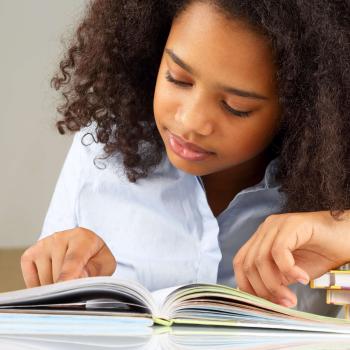Creating a Feast for the Senses With Mentor Texts

- Preview |
- Standards |
- Resources & Preparation |
- Instructional Plan |
- Related Resources |
- Comments
Overview
Students visualize and create sensory images as they read to comprehend and connect to texts. Building on this knowledge, students must learn to write in a way that will allow their readers to visualize and create sensory images. This lesson teaches students to investigate published texts to help them learn how to revise their writing to add words and phrases that will create sharp, sensory-rich experiences for their readers. Students will learn to use “the experts” for inspiration in their own writing, creating personal connections with various authors. The published texts that students use to inform their writing will become their personal “mentor texts.”
Featured Resources
Write Like… Handout: This handout gives students a chance to collect examples of sensory writing from published texts of an author.
Revising for Sensory Images Rubric: This rubric can be used to communicate expectations to students and for teacher evaluation.
My Revising for Sensory Images Checklist: This checklist will help students evaluate their own work as they revise.
Mentor Texts for Sensory Images: This is a teacher resource for picture books that can be used as mentor texts when teaching about sensory images. Author websites are also included for additional extensions.
From Theory to Practice
- Students investigate picture books in order to analyze how published authors use sensory language to help their readers create personal sensory images as they read.
- By using existing texts as models for their own writing, students learn to read like writers. Students can then begin to consciously use text models as they face the revision process.
- Young writers are taught to ask, “What have I seen in my reading life that might be a possibility for the kind of draft I’ve written?” (p. 61).
- For both students and teachers, a reference of 150 children’s books that can be used as mentor texts for 27 craft elements.
Common Core Standards
This resource has been aligned to the Common Core State Standards for states in which they have been adopted. If a state does not appear in the drop-down, CCSS alignments are forthcoming.
State Standards
This lesson has been aligned to standards in the following states. If a state does not appear in the drop-down, standard alignments are not currently available for that state.
NCTE/IRA National Standards for the English Language Arts
- 3. Students apply a wide range of strategies to comprehend, interpret, evaluate, and appreciate texts. They draw on their prior experience, their interactions with other readers and writers, their knowledge of word meaning and of other texts, their word identification strategies, and their understanding of textual features (e.g., sound-letter correspondence, sentence structure, context, graphics).
- 4. Students adjust their use of spoken, written, and visual language (e.g., conventions, style, vocabulary) to communicate effectively with a variety of audiences and for different purposes.
- 5. Students employ a wide range of strategies as they write and use different writing process elements appropriately to communicate with different audiences for a variety of purposes.
- 6. Students apply knowledge of language structure, language conventions (e.g., spelling and punctuation), media techniques, figurative language, and genre to create, critique, and discuss print and nonprint texts.
- 11. Students participate as knowledgeable, reflective, creative, and critical members of a variety of literacy communities.
- 12. Students use spoken, written, and visual language to accomplish their own purposes (e.g., for learning, enjoyment, persuasion, and the exchange of information).
Materials and Technology
- One copy of Dogzilla by Dav Pilkey (or other selected mentor text)
- One copy of a selected picture book for each student or pair of students (see Mentor Texts for Sensory Images for suggestions)
- Large chart paper or overhead or document camera, LCD projector, and screen
Printouts
Websites
Preparation
- Read Dogzilla by Dav Pilkey (or another selected mentor text) to familiarize yourself with the story and the vocabulary.
- Choose student writing samples from Writing Scored Student Work–Grade 4 (or your own resource), and make a copy for each student.
- Set up large chart paper to create an anchor chart or make an overhead of the Write Like… Handout.
Student Objectives
Students will
- Learn to recognize examples of sensory writing in published texts
- Create their own sensory writing by using published texts as a model
- Practice revision in student texts not their own and then apply that process to their own writing
Session 1
- Show students Dogzilla by Dav Pilkey (or another book you have selected). Tell students that you are going to read them a book you love that contains high-quality writing. Tell students that even though this book has great illustrations, after you read each set of pages you want them to pay attention to the pictures they have in their heads or anything they hear or feel in their imaginations before you show them the book’s pictures. As you read, pause after each set of pages to hear student responses before showing the illustrations. Read through the entire book. Allow students to briefly give their initial reactions to the story before going on.
- Tell students that you are now going to reread the book and that they are going to investigate the book with you for examples of words and phrases that help us as readers to visualize and create sensory images. If necessary, define and review with students what sensory images are.
- As you read through each set of pages, stop and ask students if there were any examples of words or phrases that helped them to see, smell, taste, hear, or feel the action. Write student contributions on large chart paper for an anchor chart or model writing on an overhead copy of the Write Like… Handout.
- After you have reread the book (or at least several pages) and have collected several examples of sensory writing, tell students that they are going to have the opportunity to investigate more books for examples of sensory writing.
- Pass out a picture book to each student or pair of students along with the Write Like… Handout (see Mentor Texts for Sensory Images for text ideas). As students are working, circulate to make sure they are able to identify appropriate examples of sensory writing. Check that students are able to identify examples of sensory writing beyond just sight and that they are quoting these examples accurately on their papers.
- For students who are struggling, ask them to find examples by one sense at a time. You might suggest that students read the entire book looking for examples of sensory writing that involve sight, and then if they are successful with that, you can lead them in rereading for another sense.
- Allow students to share books that they read and samples of sensory writing they found. Add samples to the anchor chart created for Dogzilla.
- At this point, you can continue to allow students to explore books, filling out a new Write Like… Handout for each new book, regardless of whether or not they are looking at a new author.
Session 2
- Begin by reviewing the sensory writing from the previous session and reading the collected examples of sensory writing from the class anchor chart, and pass out photocopies of student writing obtained from Writing Scored Student Work–Grade 4.
- Tell students that they are going to add sensory writing to these student drafts. (Working with someone else’s writing is a risk-free way to allow the students to practice with creating sensory images.) Allow students to work in pairs or by themselves.
- Allow students to share examples of how and where they added the sensory writing.
- Tell students that now they will be looking at their own drafts to revise for sensory writing.
- Make sure students again have access to pictures books and their Write Like… Handout from the day before to use as resources.
- Hand out and go over the Revising for Sensory Images Rubric. Explain to students that this is what you will use to evaluate their work. If you would like, you can give students the My Revising for Sensory Images Checklist so that they have a written guide of what is expected and can evaluate their own work before turning it in.
- Once students have finished their revisions, allow students to share examples of how and where they added sensory writing to their own drafts.
Extensions
- As students continue to collect examples of sensory writing in other writing sessions or in reading, allow them to write their examples on the class anchor chart(s).
- When students are able to find certain authors whose books they enjoy using for mentor texts, they can begin to investigate author websites to learn more about the author, the author’s other books, and the author’s writing process. The Mentor Texts for Sensory Images handout also includes website information.
- Use the ReadWriteThink Printing Press to publish the examples of sensory writing that students find in texts as well as examples of sensory writing from their own work. The flyer templates will work for collections of sensory writing. Students might use the booklet template to create a collection of sensory writing.
- Use either the ReadWriteThink Flip Book or Stapleless Book to publish the examples of sensory writing that students find in texts as well as examples of sensory writing from their own work.
Student Assessment / Reflections
- Collect and assess the Write Like… Handout that students used to record examples of sensory writing from published texts. Make sure students are choosing quality examples of sensory writing and are using the handout correctly.
- Collect and assess student drafts and final copies after revising for sensory writing to compare before and after.
- Assessment can also be done formally using the Revising for Sensory Images Rubric to evaluate student’s own writing after revision. The My Revising for Sensory Images Checklist can also be used by students as they work. Teachers can assign point values to either of these handouts if desired.





Add new comment